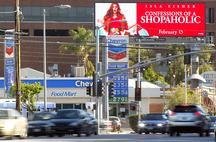
CITYWIDE — As the debate on billboards in Los Angeles drags on, activists are using Santa Monica as the shining star of municipal sign policy.
Los Angeles stemmed a growing flood of visual clutter in 2002 when the City Council passed a billboard moratorium, banning the construction of new billboards. It was immediately attacked by billboard interests and vetted by the Ninth Circuit Court of Appeals this year.
Santa Monica, however, never let it become a problem.
That’s because in 1985, the Santa Monica City Council underwent a drastic change in sign policy. Not only did it ban all billboards, it heavily regulated the size, location and type of signage that could be seen in the city. Any billboards — defined as free-standing, off-premise signs — that still stand predated the 1985 code.
Not only do signs have to be attached to buildings, signs can only advertise services or products that are sold in the store they are attached to, with the exception of corporate products, which cannot be advertised. That means the ubiquitous iPod or Coca Cola billboards that dot Downtown Los Angeles are not allowed here.
“Sign proliferation was detracting from the beauty of the city,” said Bob Holbrook, a Santa Monica City Councilman. “The council was worried about what the city would look like in 2015.”
The council reviewed the sign code in July 2008 and adopted changes in September 2008. According to Barry Rosenbaum, the senior land use attorney for the City Attorney’s Office, the council looked at recent judicial decisions and altered the code slightly to ensure that it was in accordance with state and federal law.
The main concern involved violations of the first amendment. The code was amended to protect noncommercial speech and to allow owners of signs to change the content of their signs without applying for an additional permit. That way, no accusations could be made that the content of signs was being censored, just their location.
As a result, the Santa Monica municipal code is held up by billboard activists like Dennis Hathaway, the president of the Coalition to Ban Billboard Blight, as a model for other cities to emulate.
“You realize you’re in a different kind of place with a different kind of thinking and a different kind of atmosphere,” Hathaway said.
Not that billboard companies are necessarily making it easy for Los Angeles officials to curb them. Despite the moratorium in Los Angeles, new billboards appear overnight. Increasingly, advertising companies are relying on large signs called super graphics that span the entire side of buildings. Super graphics are a new outgrowth of the debate and were not specifically regulated against in the moratorium.
“For years there’s been a sentiment in Los Angeles for making it more desirable, to control illegal billboards, but it’s just been uncoordinated,” Hathaway said. “The city decided it would be easier to make settlements than fight lawsuits. What it boils down to is that Santa Monica has the political will and you can see the results.”
Santa Monica’s size is a major factor in effective policing, making it harder for companies to engage in illegal sign construction.
“We have seven council members and there’s hardly any part of the city one of us doesn’t see every day,” Holbrook said. “And we have over 200 police officers, so if something happens they know about it immediately. We’re pretty aggressive about it.”
Problems in Los Angeles also stem from companies taking billboards digital. This new breed of billboard flashes a new ad every eight seconds, increasing exposure for companies but also adding to light pollution. Companies began converting their conventional signs into digital LED signs, pressuring the Los Angeles City Council to put a moratorium on digital billboards in December. The extra time will allow them to fix their own jumble of code concerning billboards and address safety concerns.
Some argue that they represent a hazard to drivers who are distracted by the light and the alternating picture, accusations that outdoor advertisers are quick to refute.
“Digital billboards are safety neutral,” said Jeff Golimowski, communications director for the Outdoor Advertising Association of America. “There is no correlation between the presence of digital billboards and traffic accidents.”
Safety experts and activists take issue with the studies cited by the OAAA and maintain that no comprehensive and conclusive study has yet been completed, although there are two under way.
For Hathaway, that’s a good enough reason to keep them out of circulation.
“The government shouldn’t allow them until these new studies are out,” he said. “If you allow them now, it’s like drug companies coming out with a new drug and the FDA says, ‘You can sell it, but we’ll study whether it’s safe or not … but you can sell it.’”
The state of California felt the same way. California Assemblyman Mike Feuer (D-Los Angeles) put forth Assembly Bill 109 in early January 2009, which would effectively ban digital billboards across the state. Los Angeles City Council was supposed to vote to support the ban on Friday, Jan. 30, but the vote was pushed off because the council was losing quorum.
Santa Monica banned any kind of digital sign in the revise of the municipal code in September. Previously, signs that flashed the temperature and time were allowed, but since September even those are on the city’s hit list.
In Golimowski’s mind, the complaints leveled against billboards and outdoor advertising in general are unfair.
“This is a business just like the bakery on the corner,” Golimowski said. “I think what you see in Los Angeles is a small vocal minority who’s making a lot of noise. But the average citizen, I don’t think the groundswell of negative feeling is there.”
In Santa Monica, at least, the “negative feeling” is strong and entrenched.
“I get called all the time by billboard companies,” Holbrook said. “I just tell them it probably won’t happen. Their company would die to work in Santa Monica.”
news@www.smdp.com







